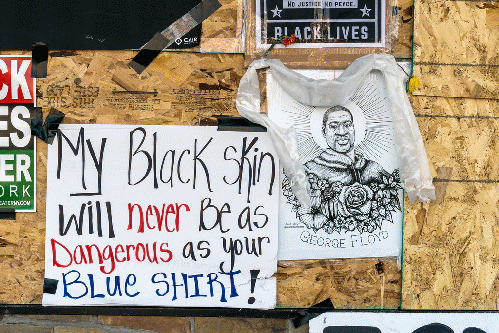From Truthout
The words "I can't breathe" were not only uttered by Eric Garner and George Floyd as they were murdered by police. They were also uttered by over 70 others who died in law enforcement custody over the past decade after saying those same three words, according to the The New York Times.
Policing in the United States is a force of racist violence that is entangled at the core of the capitalist system. As Robin D.G. Kelley pointed out on Intercepted With Jeremy Scahill, capitalism and racism are not distinct from one another: "If you think of capitalism as racial capitalism, then the outcome is you cannot eliminate capitalism, overthrow it, without the complete destruction of white supremacy, of the racial regime under which it's built."
Police in the United States act with impunity in targeted neighborhoods, public schools, college campuses, hospitals, and almost every other public sphere. Not only do the police view protesters, Black and Indigenous people, and undocumented immigrants as antagonists to be controlled, they are also armed with military-grade weapons. This police militarization is a process that dates at least as far back as President Lyndon Johnson when he initiated the 1965 Law Enforcement Assistance Act, which supplied local police forces with weapons used in the Vietnam War. The public is now regarded as dangerous and suspect; moreover, as the police are given more military technologies and weapons of war, a culture of punishment, resentment and racism intensifies as Black people, in particular, are viewed as a threat to law and order. Unfortunately, employing militarized responses to routine police practices has become normalized. One consequence is that the federal government has continued to arm the police through the Defense Logistics Agency's 1033 Program, which allows the Defense Department to transfer military equipment free of charge to local enforcement agencies.
The scope of the 1033 Program is alarming given that "Since its inception, more than 11,500 domestic law enforcement agencies have taken part in the 1033 Program, receiving more than $7.4 billion in military equipment," according to CNBC. There is also the federally run 1122 Program which allows the police to purchase military equipment at the same discounted rate as the federal government. In addition, there is the Homeland Security Grant Program, which provides funds for local police departments to buy military-grade armaments and weapons. The military-grade weapons provided through these federal programs include armored vehicles, assault rifles, flashbang grenade launchers, bomb-detonating robots, and night vision items. Arming the police with more powerful weapons reinforced a culture that taught police officers to learn, think and act as soldiers engaged in a war. Moreover, as Ryan Welch and Jack Mewhirter write in The Washington Post, the more militarized and armed the police are, the greater the increase in civilian deaths. As they point out:
"Even controlling for other possible factors in police violence (such as household income, overall and black population, violent-crime levels and drug use), more-militarized law enforcement agencies were associated with more civilians killed each year by police. When a county goes from receiving no military equipment to $2,539,767 worth (the largest figure that went to one agency in our data), more than twice as many civilians are likely to die in that county the following year."
This arming and militarizing of the police were intensified after the 9/11 attacks and privileged a police ethos defined by "the use of violent tactics and non-negotiable force over compromise, mediation, and peaceful conflict resolution." Police brutality is endemic to American history. As Mariame Kaba argues,
"There is not a single era in United States history in which the police were not a force of violence against Black people. Policing in the South emerged from the slave patrols in the 1700 and 1800s that caught and returned runaway slaves. In the North, the first municipal police departments in the mid-1800s helped quash labor strikes and riots against the rich. Everywhere, they have suppressed marginalized populations to protect the status quo."
Police brutality cannot be separated from the lethal nature of white supremacy, and in its recent incarnations became "the war on crime." Under President Nixon and every American president after him, the war on crime continued to expand and intensify into a war on Black communities. The call for "law and order" repeatedly served as a smokescreen for racist and militarized police practices that equated Black behavior with criminality and authorized the use of force against them.
As the reach of the culture of punishment expanded, its targets included protesters, immigrants, and those individuals and groups marginalized by class, religion, ethnicity and color as the other an enemy. This is the organizing principle of a war mentality adopted by the police throughout the United States in which the behavior of Black people and other marginalized communities is criminalized. It comes as no surprise that as one study reports, "Police kill, on average, 2.8 men per day". Police homicide risk is higher than suggested by official data. Black and Latino men are at higher risk for death than are White men, and these disparities vary markedly across place."
A militarized culture breeds violence. It wastes money on the security industries and policing, and drains money from the socially necessary programs that could actually prevent violence. Violence is both shocking and part of everyday life, especially for those who are poor, Black, Indigenous, trans, disabled and/or otherwise disenfranchised. In the last few decades, Francesca Mari writes, "the US has had the highest homicide rate of any high-income country, and according to preliminary data released in March by the FBI, it rose by 25 percent in 2020, when an estimated 20,000 people were murdered more than 56 a day."
Police brutality became code for a more violent expression of racism that emerged with the rise of neoliberalism in the 1980s. This was especially obvious under the Trump administration as the racist adoption of both white supremacy and a wave of police brutality against Black people and undocumented immigrants was presented to the American public as a badge of honor and an act of civic pride.
As the power of the police expanded, along with their unions, social programs were defunded. These included job programs, food stamp programs, health centers, healthcare programs and early childhood education. In many states, more money was spent on prisons than on colleges and universities, as documented by Ruth Gilmore in her book Golden Gulag: Prisons, Surplus, Crisis, and Opposition in Globalizing California. Targeted cities inhabited mostly by poor Black and brown people were now under siege as the war on poverty morphed into the war on crime. Instead of "fighting black youth poverty," the new crop of white supremacist politicians fought what Elizabeth Hinton called "fighting black youth crime" in her book From the War on Poverty to the War on Crime.
(Note: You can view every article as one long page if you sign up as an Advocate Member, or higher).






